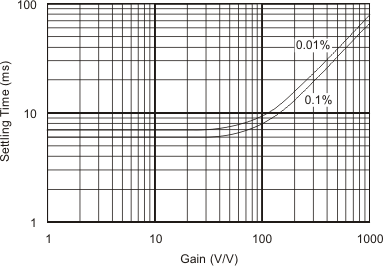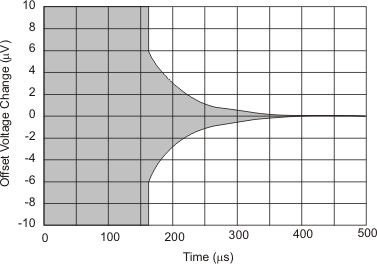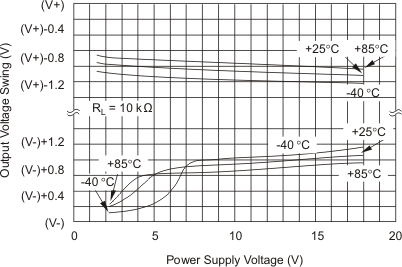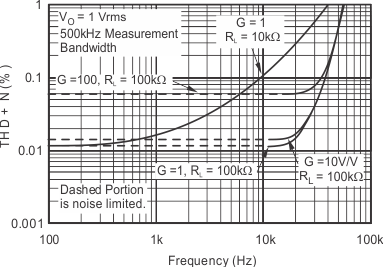SBOS508A December 2009 – December 2015 INA129-EP
PRODUCTION DATA.
- 1 Features
- 2 Applications
- 3 Description
- 4 Revision History
- 5 Pin Configuration and Functions
- 6 Specifications
- 7 Detailed Description
- 8 Application and Implementation
- 9 Power Supply Recommendations
- 10Layout
- 11Device and Documentation Support
- 12Mechanical, Packaging, and Orderable Information
Package Options
Mechanical Data (Package|Pins)
- D|8
Thermal pad, mechanical data (Package|Pins)
Orderable Information
6 Specifications
6.1 Absolute Maximum Ratings
over operating free-air temperature range (unless otherwise noted) (1)| MIN | MAX | UNIT | ||
|---|---|---|---|---|
| VS | Supply voltage | ±18 | V | |
| Analog input voltage | ±40 | V | ||
| Output short-circuit (to ground) | Continuous | |||
| TA | Operating temperature | –55 | 125 | °C |
| TJ | Junction temperature | 150 | °C | |
| Lead temperature (soldering, 10s) | 300 | °C | ||
| Tstg | Storage temperature | –55 | 125 | °C |
(1) Stresses above these ratings may cause permanent damage. Exposure to absolute maximum conditions for extended periods may degrade device reliability. These are stress ratings only, and functional operation of the device at these or any other conditions beyond those specified is not implied.
6.2 ESD Ratings
| VALUE | UNIT | ||||
|---|---|---|---|---|---|
| V(ESD) | Electrostatic discharge | Human body model (HBM), per ANSI/ESDA/JEDEC JS-001, all pins(1) | ±4000 | V | |
| Charged device model (CDM), per JEDEC specification JESD22-C101, all pins(2) | ±200 | ||||
(1) JEDEC document JEP155 states that 500-V HBM allows safe manufacturing with a standard ESD control process.
(2) JEDEC document JEP157 states that 250-V CDM allows safe manufacturing with a standard ESD control process.
6.3 Recommended Operating Conditions
over operating free-air temperature range (unless otherwise noted)| MIN | NOM | MAX | UNIT | ||
|---|---|---|---|---|---|
| V power supply | ±2.25 | ±15 | ±18 | V | |
| Input common-mode voltage range for VO = 0 | V - 2 V | V + –2 V | |||
| TA operating temperature INA129-EP | –55 | 125 | °C | ||
6.4 Thermal Information
| THERMAL METRIC(1) | INA129-EP | UNIT | |
|---|---|---|---|
| D (SOIC) | |||
| 8 PINS | |||
| RθJA | Junction-to-ambient thermal resistance | 110 | °C/W |
| RθJC(top) | Junction-to-case (top) thermal resistance | 57 | °C/W |
| RθJB | Junction-to-board thermal resistance | 54 | °C/W |
| ψJT | Junction-to-top characterization parameter | 11 | °C/W |
| ψJB | Junction-to-board characterization parameter | 53 | °C/W |
(1) For more information about traditional and new thermal metrics, see the IC Package Thermal Metrics application report, SPRA953.
6.5 Electrical Characteristics
At TA = 25°C, VS = ±15 V, RL = 10 kΩ (unless otherwise noted)| PARAMETER | TEST CONDITIONS | TA = 25°C | TA = 25°C | UNIT | ||||||||
|---|---|---|---|---|---|---|---|---|---|---|---|---|
| MIN | TYP | MAX | MIN | TYP | MAX | |||||||
| INPUT | ||||||||||||
| Offset Voltage, RTI | ||||||||||||
| Initial | TA = 25°C | ±100 ±800/G | µV | |||||||||
| Overtemperature | ±150 ±2050/G | |||||||||||
| vs power supply | TA = 25°C, VS = ±2.25 V to ±18 V | ±1.6 ±175/G | µV/V | |||||||||
| Overtemperature | ±1.8 ±175/G | |||||||||||
| Long-term stability | ±1 ±3/G | µV/mo | ||||||||||
| Impedance, differential | 1010 || 2 | Ω || pF | ||||||||||
| Common mode | 1011||9 | Ω || pF | ||||||||||
| Common mode voltage range(1) | VO = 0 V | (V+) − 2 | (V+) − 1.4 | V | ||||||||
| (V−) + 2 | (V−) + 1.7 | V | ||||||||||
| Safe input voltage | ±40 | V | ||||||||||
| Common-mode rejection | VCM = ±13 V, ΔRS = 1 kΩ |
G = 1 | 75 | 86 | dB | |||||||
| Overtemperature | 67 | |||||||||||
| G = 10 | 93 | 106 | ||||||||||
| Overtemperature | 84 | |||||||||||
| G = 100 | 113 | 125 | ||||||||||
| Overtemperature | 98 | |||||||||||
| G = 1000 | 113 | 130 | ||||||||||
| Overtemperature | 98 | |||||||||||
| CURRENT | ||||||||||||
| Bias current | ±2 | ±8 | nA | |||||||||
| Overtemperature | ±16 | |||||||||||
| Offset Current | ±1 | ±8 | nA | |||||||||
| Overtemperature | ±16 | |||||||||||
| NOISE | ||||||||||||
| Noise voltage, RTI | G = 1000, RS = 0 Ω |
f = 10 Hz | 10 | nV/√Hz | ||||||||
| f = 100 Hz | 8 | |||||||||||
| f = 1 kHz | 8 | |||||||||||
| fB = 0.1 Hz to 10 Hz | 0.2 | µVpp | ||||||||||
| Noise current | G = 1000, RS = 0 Ω |
f = 10 Hz | 0.9 | pA/√Hz | ||||||||
| f = 1 kHz | 0.3 | |||||||||||
| fB = 0.1 Hz to 10 Hz | 30 | pAPP | ||||||||||
| GAIN | ||||||||||||
| Gain equation | 1 + (49.4 kΩ/RG) |
V/V | ||||||||||
| Range of gain | 1 | 10000 | V/V | |||||||||
| Gain error | G = 1 | ±0.05% | ±0.1% | |||||||||
| Overtemperature | ±0.15% | |||||||||||
| G = 10 | ±0.02% | ±0.5% | ||||||||||
| Overtemperature | ±0.65% | |||||||||||
| G = 100 | ±0.05% | ±0.65% | ||||||||||
| Overtemperature | ±1.1% | |||||||||||
| G = 1000 | ±0.5% | ±2% | ||||||||||
| Gain vs temperature(2) | G = 1 | ±1 | ±10 | ppm/°C | ||||||||
| 49.4-kΩ resistance(2)(3) | ±25 | ±100 | ppm/°C | |||||||||
| Nonlinearity | VO = ±13.6 V, G = 1 |
±0.0001 | ±0.0018 | % of FSR | ||||||||
| Overtemperature | ±0.0035 | |||||||||||
| G = 10 | ±0.0003 | ±0.0035 | ||||||||||
| Overtemperature | ±0.0055 | |||||||||||
| G = 100 | ±0.0005 | ±0.0035 | ||||||||||
| Overtemperature | ±0.0055 | |||||||||||
| G = 1000 | ±0.001 | See (4) | ||||||||||
| OUTPUT | ||||||||||||
| Voltage | Positive | RL = 10 kΩ | (V+) − 1.4 | (V+) − 0.9 | V | |||||||
| Negative | RL = 10 kΩ | (V−) + 1.4 | (V−) + 0.8 | |||||||||
| Load capacitance stability | 1000 | pF | ||||||||||
| Short-circuit current | +6/−15 | mA | ||||||||||
| FREQUENCY RESPONSE | ||||||||||||
| Bandwidth, −3 dB | G = 1 | 1300 | kHz | |||||||||
| G = 10 | 700 | |||||||||||
| G = 100 | 200 | |||||||||||
| G = 1000 | 20 | |||||||||||
| Slew rate | VO = ±10 V, G = 10 |
4 | V/µs | |||||||||
| Settling time, 0.01% | G = 1 | 7 | µs | |||||||||
| G = 10 | 7 | |||||||||||
| G = 100 | 9 | |||||||||||
| G = 1000 | 80 | |||||||||||
| Overload recovery | 50% overdrive | 4 | µs | |||||||||
| POWER SUPPLY | ||||||||||||
| Voltage range | ±2.25 | ±15 | ±18 | V | ||||||||
| Current, total | VIN = 0 V | ±700 | ±750 | µA | ||||||||
| Overtemperature | ±1200 | |||||||||||
| TEMPERATURE RANGE | ||||||||||||
| Specification | −55 | 125 | °C | |||||||||
| Operating | −55 | 125 | °C | |||||||||
(1) Input common-mode range varies with output voltage — see Typical Characteristics.
(2) Specified by wafer test.
(3) Temperature coefficient of the 49.4-kΩ term in the gain equation.
(4) Nonlinearity measurements in G = 1000 are dominated by noise. Typical nonlinearity is ±0.001%.
6.6 Typical Characteristics
At TA = 25°C, VS = ±15 V, unless otherwise noted.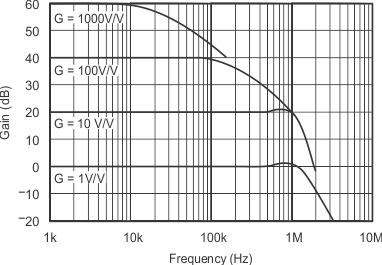
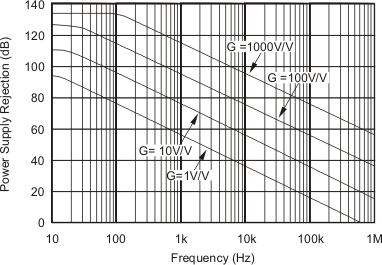
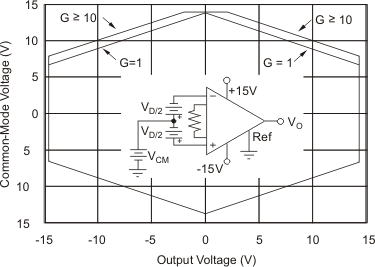
| VS = ±15 V | ||
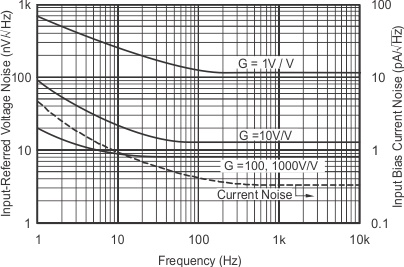
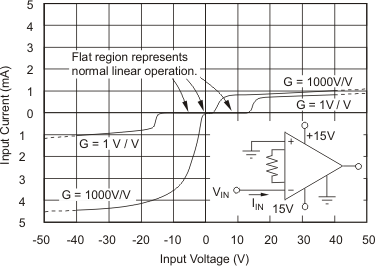
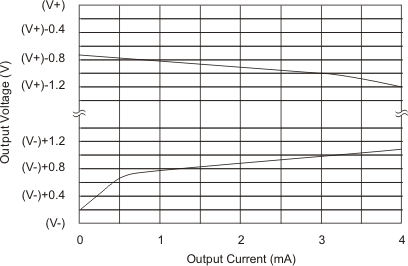
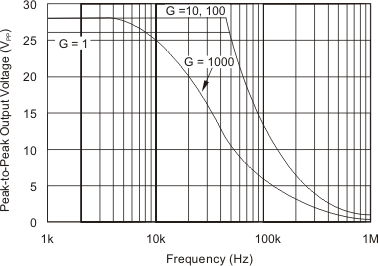
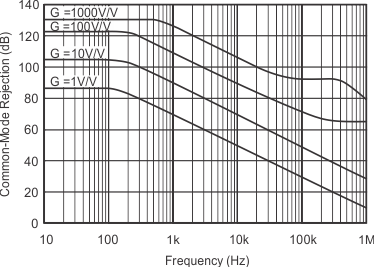
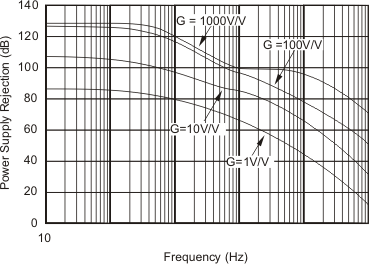
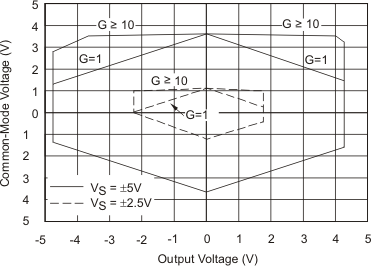
| VS = ±5 V, ±2.5 V | ||
